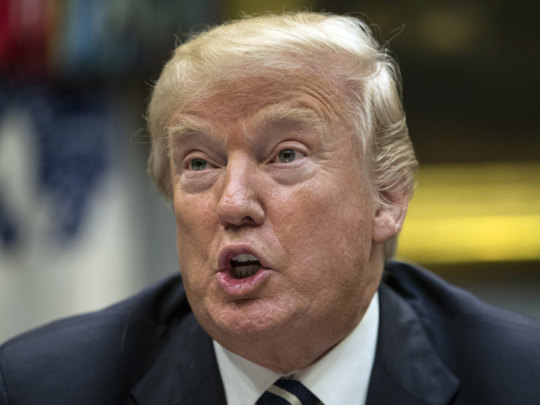
US President Donald Trump’s first year of office ends this week (Saturday 20). After his remarkable election victory in November 2016, big domestic policy wins have been very short on the ground, and multiple polls have shown him in much of 2017 to be the most unpopular White House incumbent of the modern political era.
This reflects the fact that Trump enjoyed no presidential honeymoon last year, unlike many other incumbents in the past, despite the fact that Republicans enjoyed a ‘clean sweep’ of the November 2016 federal elections, securing majorities in both houses of Congress, as well as the White House. Instead, he has largely stumbled from controversy to crisis, only last week being accused of describing Central American and African nations as “shithole countries” with lawmakers, an episode that may make proposed immigration reforms even harder to secure in coming months.
Since mid-December, Trump has had a very modest bump to his presidential approval ratings, now at 37 per cent according to the latest Gallup survey. With the Republican tax cut plan signed into law last month, the president scored his first major legislative success that could fuel the current economic expansion and help propel him to higher voter favourability and potentially even re-election in 2020.
Yet, a year into office, while Trump has shown himself to be an effective — if unorthodox — campaigner, it is still genuinely unclear what sustained level of governing competence he will demonstrate as the first president since Dwight Eisenhower never before to have held elected office. Despite the billionaire businessman’s claims of being a master deal maker, repeated setbacks in 2017 underline how different the American national political domain can be to that of running a privately-held family conglomerate where the billionaire business forged his earlier career.
The presidency provides Trump with at least two broad powers: That of setting governing themes; and that of creating interactive coalitions among the public and within Congress in support of the administration’s legislative and wider programme. Trump’s effectiveness in setting governing themes and building coalitions of support, which has been very limited to date, will depend going forward upon his ability to exploit two sources of power: The popular prestige of the presidential office, and his leadership reputation among members of Congress and senior federal bureaucrats.
Strong, effective presidents exploit each source of power interactively — as for example Democrat Franklin Roosevelt and Republican Ronald Reagan did in the 1930s-1940s and 1980s respectively. To make the presidency work most effectively, Trump will now have to try to show rapidly whether he knows how to do both, defying expectations that are held about him by many voters and political elites. Since he assumed office, the White House has instead all too often appeared riven by incompetence and confusion, as for instance outlined in the new book Fire and Fury.
Going forward, if Trump is to maximise prospects of re-election in 2020, should he indeed run for a second term, he needs to demonstrate he is capable of developing a much more powerful and appealing governing agenda that has more popular support. On the domestic front, it looks likely he will now — try — to build this around agendas like boosting infrastructure spending where there could well be majorities in Congress to cultivate in 2018.
Trump also needs to use less polarising rhetoric, and demonstrate greater reconciliation after the long, bitter election campaign in 2016. After a long period of such rancour, America may be more divided than in living memory, and he has disputed political legitimacy with many voters who favoured Democratic nominee Hillary Clinton or other candidates.
There have been only four previous occasions when a winning presidential candidate lost the popular vote, as Trump did in 2016: In 2000, when George W. Bush beat Al Gore; in 1888 when Benjamin Harrison bested Grover Cleveland; in 1876 when Rutherford Hayes beat Samuel Tilden; and in 1824 when John Quincy Adams bested Andrew Jackson. The rarity of these electoral circumstances reinforces the need for Trump to strive for a healing of frayed relations, and establish strong governing themes for his presidency which command popular understanding and support whilst affording him latitude for political development and manoeuvre.
While there is still time for Trump to potentially turn around his presidency, the partisan animosity and wider political challenges now facing him means he is still on the back foot, despite the Republican tax cut win in December. Indeed, a Monmouth University poll released last year showed that more people wanted to see Trump impeached today than was the case for then-incumbent Richard Nixon at the start of the Watergate scandal in the 1970s.
While any such impeachment proceedings against Trump are still a significant distance off, much of this talk has been driven by speculation surrounding the congressional and FBI investigations into his team’s alleged ties with Russia. This potentially brewing scandal, which could yet become a full-blown political crisis, has already claimed the scalp of Michael Flynn as national security adviser and who in December pleaded guilty to lying to the FBI about conversations with Russia’s ambassador. It has also seen a former foreign policy adviser, George Papadopoulos, pleading guilty to perjury over his contacts with Russians linked to the Kremlin; and the president’s former campaign manager, Paul Manafort, facing charges of money laundering.
Taken overall, there is still time for Trump to potentially turn his presidency around, despite repeated 2017 setbacks. In suitably skilled hands, the office offers potential for national renewal and unity at troubled times, and this remains true today despite the massive political baggage that Trump brings. The key next test will be whether he has the skill and temperament to re-energise his administration, work more effectively with congressional colleagues, and forge a multi-year domestic policy-governing agenda that can bring America closer together, rather than driving it further apart as now.
Andrew Hammond is an Associate at LSE IDEAS at the London School of Economics.








